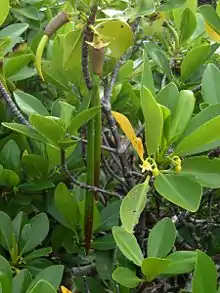| Rhizophora | |
|---|---|
 | |
| Rhizophora mangle | |
| Scientific classification | |
| Kingdom: | Plantae |
| Clade: | Tracheophytes |
| Clade: | Angiosperms |
| Clade: | Eudicots |
| Clade: | Rosids |
| Order: | Malpighiales |
| Family: | Rhizophoraceae |
| Genus: | Rhizophora L.[1] |
| Species | |
|
Several, see text | |
| Synonyms | |
|
Mangium Rumph. ex Scop.[1] | |
Rhizophora is a genus of tropical mangrove trees, sometimes collectively called true mangroves. The most notable species is the red mangrove (Rhizophora mangle) but some other species and a few natural hybrids are known. Rhizophora species generally live in intertidal zones which are inundated daily by the ocean. They exhibit a number of adaptations to this environment, including pneutomatophores that elevate the plants above the water and allow them to respire oxygen even while their lower roots are submerged and a cytological molecular "pump" mechanism that allows them to remove excess salts from their cells. The generic name is derived from the Greek words ριζα (rhiza), meaning "root," and φορος (phoros), meaning "bearing," referring to the stilt-roots.[2]
The beetle Poecilips fallax is a common pest of these trees, especially Rhizophora mucronata and Rhizophora apiculata. This beetle (related to carver beetles) lays its eggs in the hypocotyls. When they hatch, the larvae dig tunnels through the hypocotyl, distorting its shape, When the beetle pupates it leaves the plant, but the hypocotyl will no longer be able to develop normally.[3]
The red mangrove is the state tree of Delta Amacuro in Venezuela; a dark brown dye can be produced from it, which is used in Tongan ngatu cloth production.
Species
| Image | Scientific name | Common name | Distribution |
|---|---|---|---|
_flower_close-up_(15563380958).jpg.webp) | Rhizophora apiculata Blume | bakauan lalaki (Philippines) bakau minyak | Australia (Queensland and the Northern Territory), Guam, India, Indonesia, Malaysia, Micronesia, New Caledonia, Papua New Guinea, the Philippines, Singapore, the Solomon Islands, Sri Lanka, Taiwan, the Maldives, Thailand, Vanuatu, and Vietnam. |
| Rhizophora harrisonii Leechm. | Brazil, Cameroon, Colombia, Costa Rica, Ecuador, Guyana, French Guiana, Honduras, Nicaragua, Panama, Suriname, Trinidad, Tobago, and Venezuela. | ||
 | Rhizophora mangle L. | red mangrove | Tropical America, West Africa, Melanesia, Polynesia[4] |
.jpg.webp) | Rhizophora mucronata Lam. | loop-root mangrove, red mangrove or Asiatic mangrove | Africa (in southeastern Egypt; eastern Ethiopia; eastern Kenya; Madagascar; Mauritius; Mozambique; the Seychelles; Somalia; eastern side of South Africa down to Nahoon the southernmost mangrove forest in Africa; southeastern Sudan; and eastern Tanzania); Asia (in Burma; Cambodia; India; Pakistan; Iran; Indonesia; the Ryukyu Islands of Japan; Malaysia; Papua New Guinea; the Philippines; Sri Lanka; Taiwan; Thailand; and Vietnam) the South Pacific (in the Solomon Islands; and Vanuatu) and Australia (in northern Northern Territory; and northern Queensland) |
 | Rhizophora racemosa G.Mey. | Pacific coast of Central and South America, Atlantic coast of West Africa. | |
| Rhizophora samoensis (Hochr.) Salvoza | Samoan Mangrove | New Caledonia - Tonga - Samoa | |
 | Rhizophora stylosa Griff. | spotted mangrove, bakauan bato (Philippines)[5] Te tongo (Kiribati),[6] Đâng (Vietnam) | Japan, China, Taiwan, Cambodia, Vietnam, Malesia and Australia (New South Wales and Queensland) |
Hybrids
- Rhizophora × annamalayana Kathiresan (R. apiculata × R. mucronata)
- Rhizophora × lamarckii Montrouz. (R. apiculata × R. stylosa)[5]
- Rhizophora × selala (Salvoza) P.B.Tomlinson (R. mangle × R. stylosa)
Formerly placed here
- Aegiceras corniculatum (L.) Blanco (as R. corniculata L.)
- Bruguiera gymnorhiza (L.) Savigny (as R. gymnorhiza L.)
- Bruguiera parviflora (Roxb.) Wight & Arn. ex Griff. (as R. parviflora Roxb.)
- Bruguiera sexangula (Lour.) Poir. (as R. sexangula Lour.)
- Ceriops tagal (Perr.) C.B.Rob. (as R. tagal Perr.)[5]
See also
References
- 1 2 "Genus: Rhizophora L." Germplasm Resources Information Network. United States Department of Agriculture. 2006-05-12. Retrieved 2010-11-27.
- ↑ Austin, Daniel F. (2004). Florida Ethnobotany. CRC Press. p. 964. ISBN 978-0-8493-2332-4.
- ↑ Luego, Josephine N. (November 1990), "Control of Poecilips fallax Eggers", Technology Transfer Series, 1 (7): 1–3
- ↑ "Rhizophora mangle". hort.purdue.edu. Retrieved 2021-01-12.
- 1 2 3 "GRIN Species Records of Rhizophora". Germplasm Resources Information Network. United States Department of Agriculture. Retrieved 2010-11-27.
- ↑ "Kiribati Country Report to The Conference of Parties (COP) of The Convention on Biological Diversity (CBD)" (PDF). Environment and Conservation Division, Ministry of Environment, Lands and Agricultural Development. p. 5. Retrieved 28 November 2012.
External links
- "Rhizophora L." Atlas of Living Australia.
 Media related to Rhizophora at Wikimedia Commons
Media related to Rhizophora at Wikimedia Commons Data related to Rhizophora at Wikispecies
Data related to Rhizophora at Wikispecies